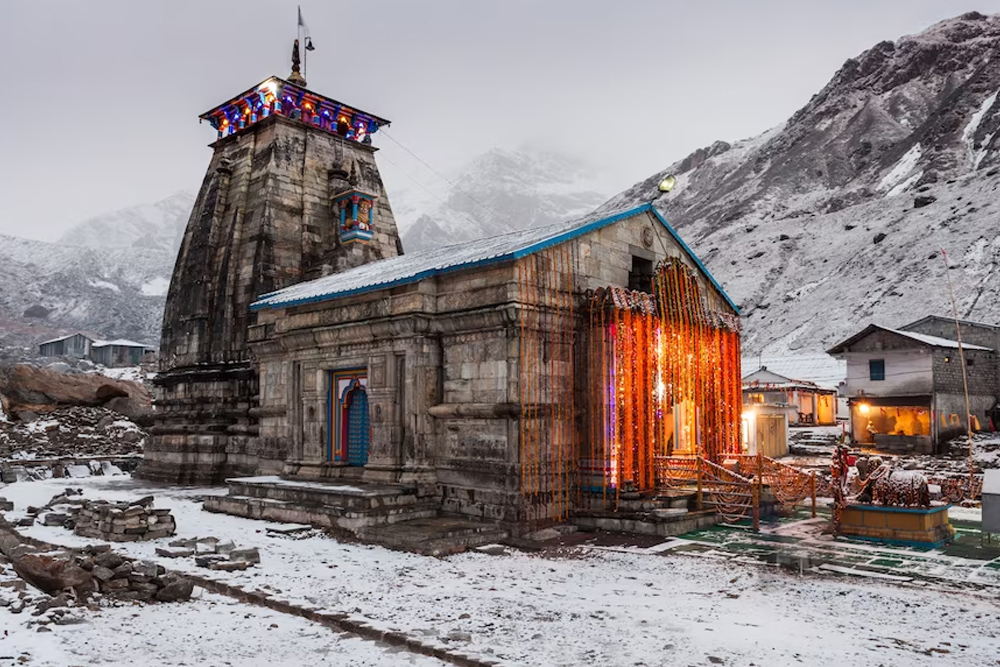Kedarnath Temple: A Sacred Haven amidst the Himalayas
- Home
- Kedarnath Temple: A Sacred Haven amidst the Himalayas
Kedarnath Temple: A Sacred Haven amidst the Himalayas

Kedarnath Temple, known as the 'temple of the God of the field' in Sanskrit, stands as a revered Hindu sanctuary nestled in the Garhwal Himalayan range near the Mandakini river in Uttarakhand, India. As one of the twelve Jyotirlingas of Shiva, it holds immense spiritual significance. Due to the harsh weather conditions, the temple welcomes devotees only between April (Akshaya Tritiya) and November (Kartik Purnima, the autumn full moon). During winters, the deity is worshipped in Ukhimath for six months.
Access to the temple isn't straightforward; it requires a strenuous 22-kilometer uphill trek from Gaurikund. Visitors can avail of pony, mule, or manchan services for the journey. According to Hindu lore, the temple was originally constructed by the Pandavas to honor Shiva, whom they pleased through penance at Kedarnath.
Kedarnath Temple holds a prime position in India's Chota Char Dham pilgrimage and is the first stop of the Panch Kedar pilgrimage sites. It stands as the highest among the twelve Jyotirlingas and is revered in Tamil Shaivite texts as one of the 275 paadal petra sthalams.
Despite being severely affected by the 2013 flash floods in North India, the temple structure remained largely intact, protected by a large rock amidst the debris. Though the surrounding areas suffered extensive damage, Kedarnath Temple stood resilient, symbolizing strength amidst adversity.
Trending Services For More Services Click here

News Portal Website Development Company In India
Website Designers

Edit connect you to customers
Business

Ram Lal Khachodi wala
Food and beverages

Neelam Sales Agency
Wallets

Neelam Sales Agency
Food and beverages

Trimwebsolutions 123
Website Designers

Trimwebsolutions 123
Sofas

Trimwebsolutions
Website Designers

Trimwebsolutions 123
Sofas

website design
Wallets

Neelam Sales Agency
Monitors

Khushboo Sales Agency
Fashion

website design
Sunglass

Accounting Service
Professional Services

Website Design and Development Company
Website Designers

Website Design and Development Company
Website Designers

Website Design and Development Company
Website Designers

Amit Repair Shop
Repairs

World Wide Printers
Printers

NHL Electro Hub Electronic Goods Showrooms
Electronics

Neelam Sales Agency
Computers

Bansal Properties
Business

Fresh & Fine Restaurant
Restaurant

High On Food
Restaurant

Lord of the Drinks East
Restaurant

Breakin’ Brew
Restaurant

Desi Punjabi Rasoi
Restaurant

Maini's Green Leaf Maini's Green Leaf
Restaurant

The Barbeque Company
Restaurant

Promenade - Indian Restaurant
Restaurant

The Salt Cafe Kitchen & Bar
Restaurant

PUNJABI CAFE
Restaurant

PUNJABI CAFE
Restaurant

Anardana East Delhi
Restaurant

The Yellow Chilli
Restaurant

BARAAMDA KITCHEN
Restaurant

QD's Restaurant
Restaurant

The Barbeque Company
Restaurant

Barsoom frat House
Restaurant

Haldiram's - Lajpat Nagar
Restaurant

The Big Chill Cafe
Restaurant

Abhishek Restaurant
Restaurant

Olive Bar & Kitchen
Restaurant

In The Punjab in delhi
Restaurant

Tastes of food
Restaurant

Nayak South Indian Foods
Restaurant

Empress Of China
Restaurant

The Clay Oven Restaurant
Restaurant

Barbeque Nation
Restaurant

Dream circle pizza
Restaurant

The Irish House, Nehru Place
Restaurant

Music & Mountains Hillside Cafe
Restaurant

Crazy kitchen
Restaurant

Noire - Live Kitchen
Restaurant

J U G G E R N A U T
Restaurant

FIO - Cookhouse & Bar
Restaurant

Oh! Calcutta
Restaurant

Kiara Soul Kitchen
Restaurant

Olive Bar & Kitchen
Restaurant

Madurai South Indian Food
Restaurant

Branch kitchen and bar
Restaurant

Burma Burma Restaurant & Tea Room
Restaurant

The South Delhi Kitchen
Restaurant




